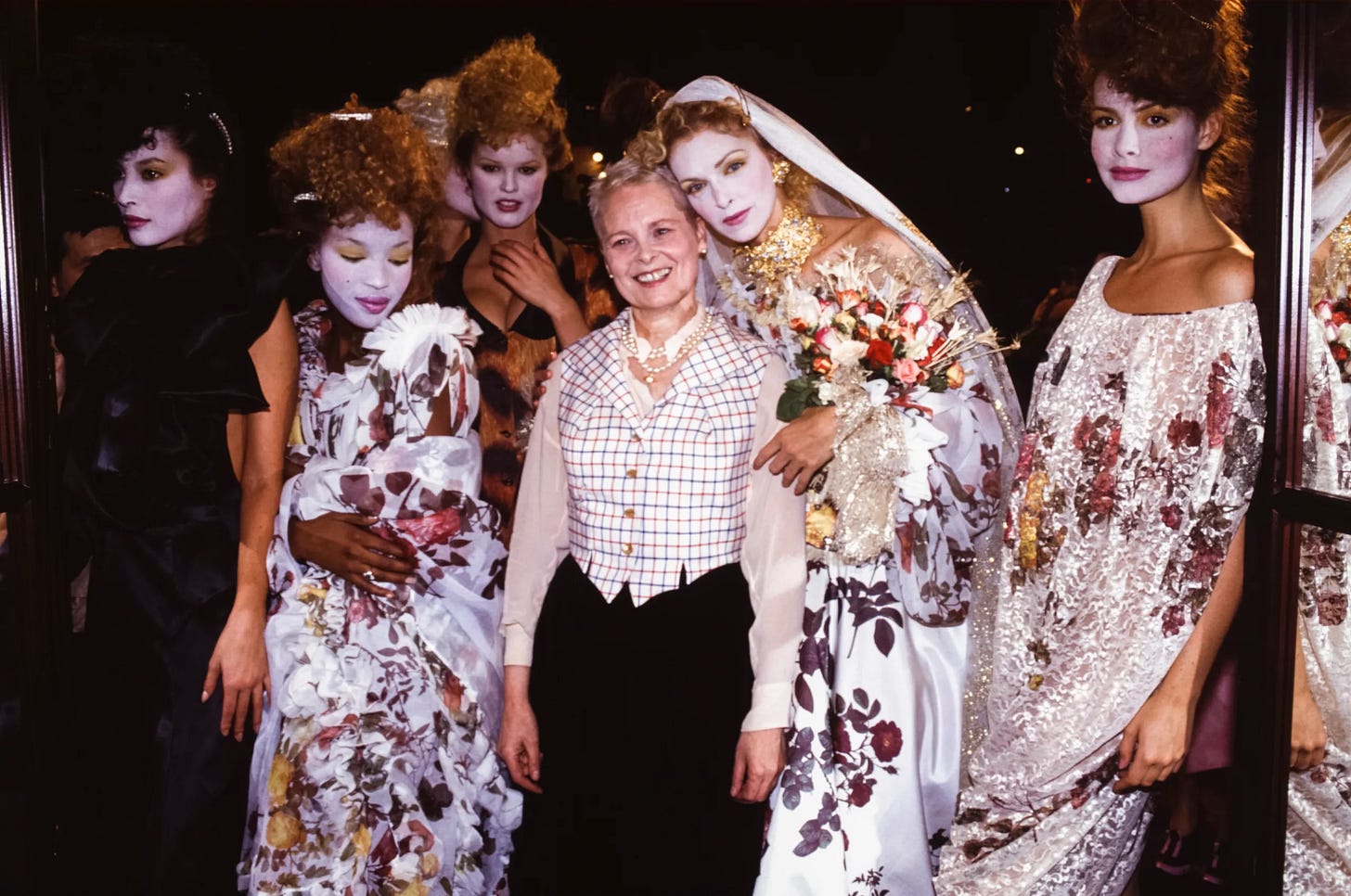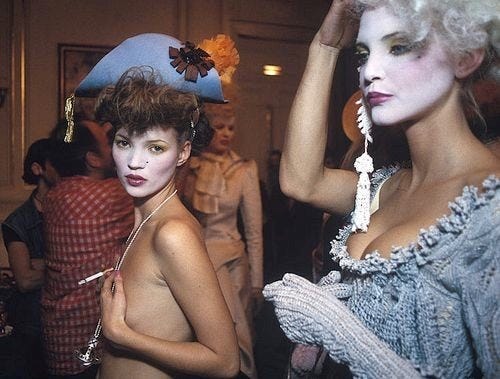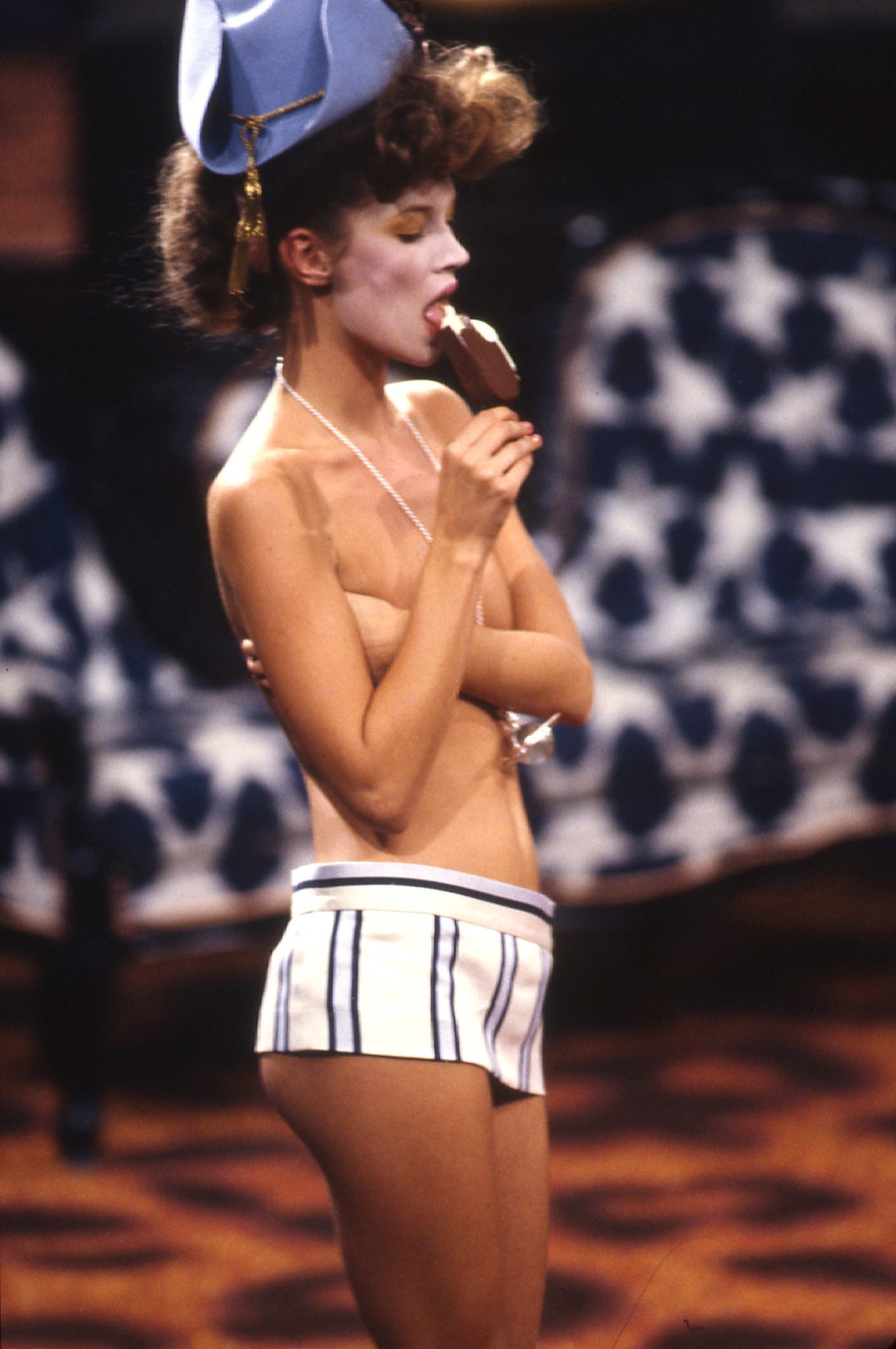It is one thing to make clothes, it is a completely different thing to design clothing that transcends time.
This common sentiment fundamentally changed the way I reflect on collections of years past. I started taking runway analyses seriously during the 2020 Met Gala, About Time: Fashion and Duration, when my friends and I created an open-participation online event called the High Fashion Twitter Met Gala. For our book, Temporal Conflation: Time and Duration, we wanted to focus not only on how fashion evolves overtime, but also how it is cyclical and internally referencing, so it comes as no surprise that one of our initial sources of inspiration was Vivienne Westwood’s Spring/Summer 1994 collection, Café Society.
The British fashion designer, Vivienne Westwood, rose to popularity in the 1970s through her partnership with Malcolm McLaren who was widely known for managing the punk rock band known as the Sex Pistols and recruiting their frontman Johnny Rotten. In 1977 when the Sex Pistols’ album God Save the Queen went No.1 on the NME charts, Westwood, who at the time was their designer and stylist, was amplified as a prominent figure in the punk movement.
This authority stayed with her even after the disbandment of the Sex Pistols as she transitioned into a full-time fashion designer with her eponymous brand, Vivienne Westwood.
Westwood was commonly known for challenging authority and the expectations for women in the fashion industry; one popular way she did so was by taking the construction of historical garments and subverting, or rather parodying, them through a provocative punk lens. One of the first examples of this was in the 1980s when Westwood began designing a garment that is now synonymous with her brand: the mini-crini.

Inspired by the Victorian cage-crinoline, Vivienne Westwood’s ‘mini-crini’ takes two challenging ideas: restriction and liberation; both in the literal connotation of how the garment is constructed and in society’s interpretation of the woman who wears it.
“If the crinoline stands in for a mythology of restriction and encumbrance in women's dress, in the mini-crini that mythology is juxtaposed with an equally dubious mythology of liberation associated with the mini-skirt. In it two sets of ideas about female desirability are conflated: one about covering, the other about uncovering the female body… In terms of a sartorial mythology these garments evoke a combination of tyranny and moralism that is repugnant to twentieth-century views of both women and fashion. Westwood picks out garments such as the crinoline because they are anathematized, in the same way as bondage wear.” - Caroline Evans, Women & Fashion: A New Look, 1989.
As Vivienne Westwood’s popularity grew, so did her stage. These singular subversive garments became entire subversive presentations which is what led to the Spring/Summer 1994 collection known as Café Society.
Café Society is a retelling of European History and how it has shaped women’s dress. The central question of this show is: what does a woman free from restriction look like? Although this show is filled with historical fashion references, Westwood subverts them by placing it on a new canvas, a liberated woman.
As a challenger of authority in the fashion industry, it only make sense for Westwood to start at the very beginning. Café Society draws inspiration from the 19th century designer and founder of the first haute couture house, Charles Fredrick Worth. The Victorian era designer founded The House of Worth in 1858 and quickly became successful by designing one-of-a-kind wedding dresses, ballgowns, and other special event pieces for performers and members of high society.
Vivienne Westwood calls on elements of his design, such as his ivory tassels, and places it on a body that is free from restrictive garments like the Victorian bustle and bodice.

Westwood also references the portraits of the 17th century artist, Anthony Van Dyck. Café Society takes direction from the Baroque painter illustrating cues of social status in the wardrobes of his subjects. She then challenges these signals of authority by placing them on the people they were intended to separate themselves from. This is seen through Westwood’s famous court platforms, meant to resemble that of nobility’s, on the feet of women who are presumably prostitutes.

“Van Dyck's paintings are filled with such deliberate gestures and, more than one might suspect, they are the same fashion gestures that people use today to express status, taste and anti-fashion attitudes.” - Cathy Horyn, From Flemish Flourishes to Soho So What, The Washington Post, Nov. 1990.

Vivienne Westwood satirized the Napoleonic Era as well with a mixture of pastel colored bicornes, worn by the emperor and his generals, and men’s silhouettes from the Bourbon Restoration, the period following Napoleon’s first fall.


By making these to periods of fashion compatible with each other, Westwood illustrates how the history of war and power is driven by the same thing that drives the subjection of women — male egoism and patriarchy.
Westwood’s signature of conflating restriction and liberation returns with a much shorter version of her 1985 mini-crini (the micromini-crini, if you will) on a topless Kate Moss. This contrast is further highlighted by the presence of Elizabethan hair and makeup. The cosmetics are a contradiction in itself: not only is it the only historical reference that is inspired by a woman’s reign, but — since this style of makeup came with physical repercussions such as lead and mercury poisoning — it illustrates that, even during periods of female authority, there is still a looming pressure to comply to dangerous beauty standards to either attract men or separate themselves from other (poorer) women

Although the collection is completely filled with historical references, Vivienne Westwood gives it a level of fantasy by letting liberated women relive (and retell) it. This allows Café Society to transcend time by permitting modern women to insert themselves in the past, giving historic women a glimpse at the present, and allowing all of us to fantasize about a more freeing future.
Vivienne Westwood | Spring/Summer 1994 | Runway Show | Café Society :
**This video is mislabeled, it is from 1994 not 1995, but this was the only video on YouTube that included all parts of the show :)




